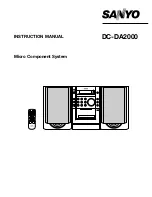
D8B Manual • Chapter 3 • page 64
Close All (Ctrl+\)
This command closes all open windows. The
main faders overview backdrop is always displayed
unless the Desktop is selected.
The Desktop Window (Ctrl+D)
The Desktop is where files are saved, named,
copied, and organized. See the description in this
chapter under the File menu (page 52).
The Setup Window (Ctrl+1)
General
These personal preference settings are
straight ahead. What’s the date and time? Do you
like the mouse to be quick and nimble or a bit
more deliberate? Do you want the on-screen
interface to look more Mac-like (Gray Motif) or
PC-esque (PC/UNIX)?
Smart Save is a function that automatically
saves your session every five minutes. Check the
Create New Files box to save the session as a new
session without overwriting the previously saved
version.
Display Intensity refers to the control surface
VFD display, not the computer monitor display.
MDS Network
MDS Network (Mackie Digital Systems
Network) allows any number of consoles that are
on the same MDS Network Channel to either
generate or receive common Link Option control-
ler actions. There are 8 MDS Channels, that are
not unlike TV channels via ethernet, where the
console has a unique Device Name (like 'Jolene' or
'Spike') and after setting the Device Name and
assigning one of the 8 MDS Channels, the console
may then join the party.
Consoles are normally linked audio-wise via
the ALT I/O 1–8 card slot where audio buses are
configured to be transferred from a slave console
to a master console for further mix processing. If
using the buses for digital audio, all allowances
for word sync must be made (both consoles need
to be clocked from the same source).
Note:
All of these Ethernet messages are
broadcast from any given control surface that is
on-line and transmitting or receiving. Updating
only occurs after the connection is established and
the link parameters are modified.
Network Channel
• Each Digital 8•Bus assigned to the same Network
Channel is linked according to the functions
selected under Link Options.
• Communication between devices is dependent on
common network channel numbers. All devices
assigned to Network Channel 1 communicate
together and act as one console across the
selected Link Options. All devices on Network
Channel 2 communicate; all devices on Network
Channel 3 communicate; etc.
• Communication between all devices sharing a
common Network Channel is bidirectional on
common Link Option selections.
Device Name
• This simply allows the D8B to be given a unique
name for identification purposes across the network.
Alt I/O 1–8
• This provides for the routing of the audio signals
from Aux 1–12, Bus 1–8, or L/R output through
any I/O card installed in the Alt I/O slot.
Link Options
• This provides the selection of control signals that
are sent or received on the ethernet connection.
• When multiple D8Bs are linked together via their
individual ethernet connections, they
communicate and respond according to the
selections in the Link Options list.
• Whichever parameters are selected are
transmitted and received across the network on
two or more D8Bs.
• Whichever parameters are not selected act
independently on each individual D8B.
Summary of Contents for D8B 3.0
Page 8: ...D8B Manual Preface page 2 ...
Page 9: ...D8B Manual Chapter 1 page 3 Chapter 1 Getting Ready ...
Page 27: ...D8B Manual Chapter 2 page 21 Chapter 2 Where Is It ...
Page 47: ...D8B Manual Chapter 3 page 41 Chapter 3 What s On TV ...
Page 93: ...D8B Manual Chapter 4 page 87 Chapter 4 Applications ...
















































